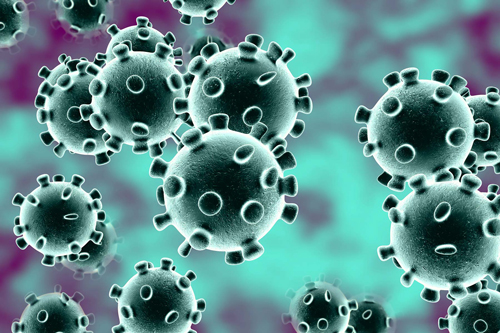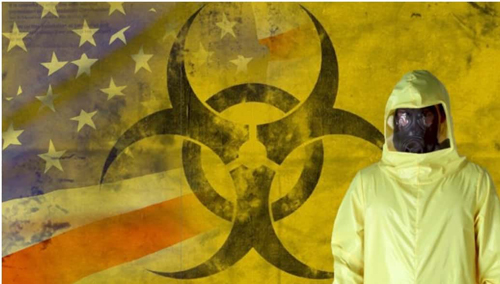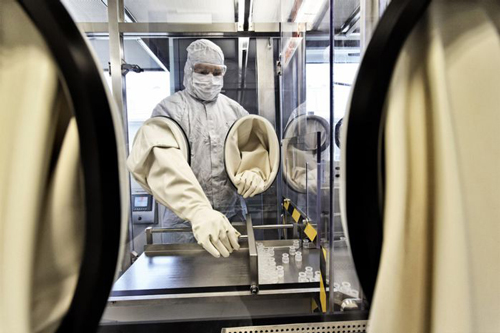Bats, gene editing and bioweapons (2)
…recent DARPA experiments raise concerns amid coronavirus outbreak
Read the first part of the article
The Pentagon in Wuhan?
Beyond the U.S. military’s recent expenditures on and interest in the use of bats of bioweapons, it is also worth examining the recent studies the military has funded regarding bats and “novel coronaviruses,” such as that behind the recent outbreak, that have taken place within or in close proximity to China.

For instance, one study conducted in Southern China in 2018 resulted in the discovery of 89 new “novel bat coronavirus” strains that use the same receptor as the coronavirus known as Middle East Respiratory Syndrome (MERS). That study was jointly funded by the Chinese government’s Ministry of Science and Technology, USAID — an organization long alleged to be a front for U.S. intelligence, and the U.S. National Institute of Health — which has collaborated with both the CIA and the Pentagon on infectious disease and bioweapons research.
The authors of the study also sequenced the complete genomes for two of those strains and also noted that existing MERS vaccines would be ineffective in targeting these viruses, leading them to suggest that one should be developed in advance. This did not occur.
Another U.S. government-funded study that discovered still more new strains of “novel bat coronavirus” was published just last year. Titled “Discovery and Characterization of Novel Bat Coronavirus Lineages from Kazakhstan,” focused on “the bat fauna of central Asia, which link China to eastern Europe” and the novel bat coronavirus lineages discovered during the study were found to be “closely related to bat coronaviruses from China, France, Spain, and South Africa, suggesting that co-circulation of coronaviruses is common in multiple bat species with overlapping geographical distributions.” In other words, the coronaviruses discovered in this study were identified in bat populations that migrate between China and Kazakhstan, among other countries, and is closely related to bat coronaviruses in several countries, including China.
The study was entirely funded by the U.S. Department of Defense, specifically the Defense Threat Reduction Agency (DTRA) as part of a project investigating coronaviruses similar to MERS, such as the aforementioned 2018 study. Yet, beyond the funding of this 2019 study, the institutions involved in conducting this study are also worth noting given their own close ties to the U.S. military and government.
The study’s authors are affiliated with either the Kazakhstan-based Research Institute for Biological Safety Problems and/or Duke University. The Research Institute for Biological Safety Problems, though officially a part of Kazakhstan’s National Center for Biotechnology, has received millions from the U.S. government, most of it coming from the Pentagon’s Cooperative Threat Reduction Program. It is the Kazakhstan government’s official depository of “highly dangerous animal and bird infections, with a collection of 278 pathogenic strains of 46 infectious diseases.” It is part of a network of Pentagon-funded “bioweapons labs” throughout the Central Asian country, which borders both of the U.S.’ top rival states — China and Russia.
Duke University’s involvement with this study is also interesting given that Duke is a key partner of DARPA’s Pandemic Prevention Platform (P3) program, which officially aims “to dramatically accelerate discovery, integration, pre-clinical testing, and manufacturing of medical countermeasures against infectious diseases.” The first step of the Duke/DARPA program involves the discovery of potentially threatening viruses and “develop[ing] methods to support viral propagation, so that virus can be used for downstream studies.”
Duke University is also jointly partnered with China’s Wuhan University, which is based in the city where the current coronavirus outbreak began, which resulted in the opening of the China-based Duke Kunshan University (DKU) in 2018. Notably, China’s Wuhan University — in addition to its partnership with Duke — also includes a multi-lab Institute of Medical Virology that has worked closely with the US Army Medical Research Institute for Infectious Diseases since the 1980s, according to its website. As previously noted, the USAMRIID facility in the U.S. was shut down last July for failures to abide by biosafety and proper waste disposal procedures, but was allowed to partially resume some experiments late last November.
The Pentagon’s Dark History of Germ Warfare

The U.S. military has a troubling past of having used disease as a weapon during times of war. One example involved the U.S.’ use of germ warfare during the Korean War, when it targeted both North Korea and China by dropping diseased insects and voles carrying a variety of pathogens — including bubonic plague and hemorrhagic fever — from planes in the middle of the night. Despite the mountain of evidence and the testimony of U.S. soldiers involved in that program, the U.S. government and military denied the claims and ordered the destruction of relevant documentation.
In the post World War II era, other examples of U.S. research aimed at developing biological weapons have emerged, some of which have recently received media attention. One such example occurred this past July, when the U.S. House of Representatives demanded information from the U.S. military on its past efforts to weaponize insects and Lyme disease between 1950 and 1975.
The U.S. has claimed that it has not pursued offensive biological weapons since 1969 and this has been further supported by the U.S.’ ratification of the Biological Weapons Convention (BWC), which went into effect in 1975. However, there is extensive evidence that the U.S. has continued to covertly research and develop such weapons in the years since, much of it conducted abroad and outsourced to private companies, yet still funded by the U.S. military. Several investigators, including Dilyana Gaytandzhieva, have documented how the U.S. produces deadly viruses, bacteria and other toxins at facilities outside of the U.S. — many of them in Eastern Europe, Africa and South Asia — in clear violation of the BWC.
Aside from the military’s own research, the controversial neoconservative think tank, the now defunct Project for a New American Century (PNAC), openly promoted the use of a race-specific genetically modified bioweapon as a “politically useful tool.” In what is arguably the think tank’s most controversial document, titled “Rebuilding America’s Defenses,” there are a few passages that openly discuss the utility of bioweapons, including the following sentences:
“…combat likely will take place in new dimensions: in space, ‘cyber-space,’ and perhaps the world of microbes…advanced forms of biological warfare that can ‘target’ specific genotypes may transform biological warfare from the realm of terror to a politically useful tool.”
Though numerous members of PNAC were prominent in the George W. Bush administration, many of its more controversial members have again risen to political prominence in the Trump administration.
Several years after “Rebuilding America’s Defenses” was published, the U.S. Air Force published a document entitled “Biotechnology: Genetically Engineered Pathogens,” which contains the following passage:
“The JASON group, composed of academic scientists, served as technical advisers to the U. S. government. Their study generated six broad classes of genetically engineered pathogens that could pose serious threats to society. These include but are not limited to binary biological weapons, designer genes, gene therapy as a weapon, stealth viruses, host-swapping diseases, and designer diseases (emphasis added).”
Concerns about Pentagon experiments with biological weapons have garnered renewed media attention, particularly after it was revealed in 2017 that DARPA was the top funder of the controversial “gene drive” technology, which has the power to permanently alter the genetics of entire populations while targeting others for extinction. At least two of DARPA’s studies using this controversial technology were classified and “focused on the potential military application of gene drive technology and use of gene drives in agriculture,” according to media reports.
The revelation came after an organization called the ETC Group obtained over 1,000 emails on the military’s interest in the technology as part of a Freedom of Information Act (FOIA) request. Co-director of the ETC Group Jim Thomas said that this technology may be used as a biological weapon:
“Gene drives are a powerful and dangerous new technology and potential biological weapons could have disastrous impacts on peace, food security and the environment, especially if misused. The fact that gene drive development is now being primarily funded and structured by the US military raises alarming questions about this entire field.”
Though the exact motivation behind the military’s interest in such technology is unknown, the Pentagon has been open about the fact that it is devoting much of its resources towards the containment of what it considers the two greatest threats to U.S. military hegemony: Russia and China. China has been cited as the greatest threat of the two by several Pentagon officials, including John Rood, the Pentagon’s top adviser for defense policy, who described China as the greatest threat to “our way of life in the United States” at the Aspen Security Forum last July.
Since the Pentagon began “redesigning” its policies and research towards a “long war” with Russia and China, the Russian military has accused the U.S. military of harvesting DNA from Russians as part of a covert bioweapon program, a charge that the Pentagon has adamantly denied. Major General Igor Kirillov, the head of the Russian military’s radiation, chemical and biological protection unit who made these claims, also asserted that the U.S. was developing such weapons in close proximity to Russian and Chinese borders.
China has also accused the U.S. military of harvesting DNA from Chinese citizens with ill intentions, such as when 200,000 Chinese farmers were used in 12 genetic experiments without informed consent. Those experiments had been conducted by Harvard researchers as part of a U.S. government-funded project.
DARPA and its partners chosen to develop coronavirus vaccine

Recently, the Coalition for Epidemic Preparedness Innovations (CEPI) announced that it would fund three separate programs in order to promote the development of a vaccine for the new coronavirus responsible for the current outbreak.
CEPI — which describes itself as “a partnership of public, private, philanthropic and civil organizations that will finance and co-ordinate the development of vaccines against high priority public health threats” — was founded in 2017 by the governments of Norway and India along with the World Economic Forum and the Bill and Melinda Gates Foundation. Its massive funding and close connections to public, private and non-profit organizations have positioned it to be able to finance the rapid creation of vaccines and widely distribute them.
CEPI’s recent announcement revealed that it would fund two pharmaceutical companies — Inovio Pharmaceuticals and Moderna Inc. — as well as Australia’s University of Queensland, which became a partner of CEPI early last year. Notably, the two pharmaceutical companies chosen have close ties to and/or strategic partnerships with DARPA and are developing vaccines that controversially involve genetic material and/or gene editing. The University of Queensland also has ties to DARPA, but those ties are not related to the university’s biotechnology research, but instead engineering and missile development.
For instance, the top funders of Inovio Pharmaceuticals include both DARPA and the Pentagon’s Defense Threat Reduction Agency (DTRA) and the company has received millions in dollars in grants from DARPA, including a $45 million grant to develop a vaccine for Ebola. Inovio specializes in the creation of DNA immunotherapies and DNA vaccines, which contain genetically engineered DNA that causes the cells of the recipient to produce an antigen and can permanently alter a person’s DNA. Inovio previously developed a DNA vaccine for the Zika virus, but — to date — no DNA vaccine has been approved for use in humans in the United States. Inovio was also recently awarded over $8 million from the U.S. military to develop a small, portable intradermal device for delivering DNA vaccines jointly developed by Inovio and USAMRIID.
However, the CEPI grant to combat coronavirus may change that, as it specifically funds Inovio’s efforts to continue developing its DNA vaccine for the coronavirus that causes MERS. Inovio’s MERS vaccine program began in 2018 in partnership with CEPI in a deal worth $56 million. The vaccine currently under development uses “Inovio’s DNA Medicines platform to deliver optimized synthetic antigenic genes into cells, where they are translated into protein antigens that activate an individual’s immune system” and the program is partnered with U.S. Army Medical Research Institute of Infectious Diseases (USAMRIID) and the NIH, among others. That program is currently undergoing testing in the Middle East.
Inovio’s collaboration with the U.S. military in regards to DNA vaccines is nothing new, as their past efforts to develop a DNA vaccine for both Ebola and Marburg virus were also part of what Inovio’s CEO Dr. Joseph Kim called its “active biodefense program” that has “garnered multiple grants from the Department of Defense, Defense Threat Reduction Agency (DTRA), National Institute of Allergy and Infectious Diseases (NIAID), and other government agencies.”
CEPI’s interest in increasing its support to this MERS-specific program seems at odds with its claim that doing so will combat the current coronavirus outbreak, since MERS and the novel coronavirus in question are not analogous and treatments for certain coronaviruses have been shown to be ineffective against other strains.
It is also worth noting that Inovio Pharmaceuticals was the only company selected by CEPI with direct access to the Chinese pharmaceutical market through its partnership with China’s ApolloBio Corp., which currently has an exclusive license to sell Inovio-made DNA immunotherapy products to Chinese customers. The second pharmaceutical company that was selected by CEPI to develop a vaccine for the new coronavirus is Moderna Inc., which will develop a vaccine for the novel coronavirus of concern in collaboration with the U.S. NIH and which will be funded entirely by CEPI. The vaccine in question, as opposed to Inovio’s DNA vaccine, will be a messenger RNA (mRNA) vaccine. Though different than a DNA vaccine, mRNA vaccines still use genetic material “to direct the body’s cells to produce intracellular, membrane or secreted proteins.” Moderna’s mRNA treatments, including its mRNA vaccines, were largely developed using a $25 million grant from DARPA and it often touts is strategic alliance with DARPA in press releases. Moderna’s past and ongoing research efforts have included developing mRNA vaccines tailored to an individual’s unique DNA as well as an unsuccessful effort to create a mRNA vaccine for the Zika Virus, which was funded by the U.S. government.

Both DNA and mRNA vaccines involve the introduction of foreign and engineered genetic material into a person’s cells and past studies have found that such vaccines “possess significant unpredictability and a number of inherent harmful potential hazards” and that “there is inadequate knowledge to define either the probability of unintended events or the consequences of genetic modifications.” Nonetheless, the climate of fear surrounding the coronavirus outbreak could be enough for the public and private sector to develop and distribute such controversial treatments due to fear about the epidemic potential of the current outbreak.
However, the therapies being developed by Inovio, Modern and the University of Queensland are in alignment with DARPA’s objectives regarding gene editing and vaccine technology. For instance, in 2015, DARPA geneticist Col. Daniel Wattendorf described how the agency was investigating a “new method of vaccine production [that] would involve giving the body instructions for making certain antibodies. Because the body would be its own bioreactor, the vaccine could be produced much faster than traditional methods and the result would be a higher level of protection.”
According to media reports on Wattendorf’s statements at the time, the vaccine would be developed as follows:
“Scientists would harvest viral antibodies from someone who has recovered from a disease such as flu or Ebola. After testing the antibodies’ ability to neutralize viruses in a petri dish, they would isolate the most effective one, determine the genes needed to make that antibody, and then encode many copies of those genes into a circular snippet of genetic material — either DNA or RNA, that the person’s body would then use as a cookbook to assemble the antibody.”
Though Wattendorf asserted that the effects of those vaccines wouldn’t be permanent, DARPA has since been promoting permanent gene modifications as a means of protecting U.S. troops from biological weapons and infectious disease. “Why is DARPA doing this? [To] protect a soldier on the battlefield from chemical weapons and biological weapons by controlling their genome — having the genome produce proteins that would automatically protect the soldier from the inside out,” then-DARPA director Steve Walker (now with Lockheed Martin) said this past September of the project, known as “Safe Genes.”
Conclusion
Research conducted by the Pentagon, and DARPA specifically, has continually raised concerns, not just in the field of bioweapons and biotechnology, but also in the fields of nanotechnology, robotics and several others. DARPA, for instance, has been developing a series of unsettling research projects that ranges from microchips that can create and delete memories from the human brain to voting machine software that is rife with problems.
Now, as fear regarding the current coronavirus outbreak begins to peak, companies with direct ties to DARPA have been tasked with developing its vaccine, the long-term human and environmental impacts of which are unknown and will remain unknown by the time the vaccine is expected to go to market in a few weeks time. Furthermore, DARPA and the Pentagon’s past history with bioweapons and their more recent experiments on genetic alteration and extinction technologies as well as bats and coronaviruses in proximity to China have been largely left out of the narrative, despite the information being publicly available. Also left out of the media narrative have been the direct ties of both the USAMRIID and DARPA-partnered Duke University to the city of Wuhan, including its Institute of Medical Virology.
Though much about the origins of the coronavirus outbreak remains unknown, the U.S. military’s ties to the aforementioned research studies and research institutions are worth detailing as such research — while justified in the name of “national security” — has the frightening potential to result in unintended, yet world-altering consequences. The lack of transparency about this research, such as DARPA’s decision to classify its controversial genetic extinction research and the technology’s use as a weapon of war, compounds these concerns. While it is important to avoid reckless speculation as much as possible, the information in this report is in the public interest and readers should use this information to reach their own conclusions about the topics discussed herein.
yogaesoteric
April 10, 2020
Also available in:
 Français
Français
